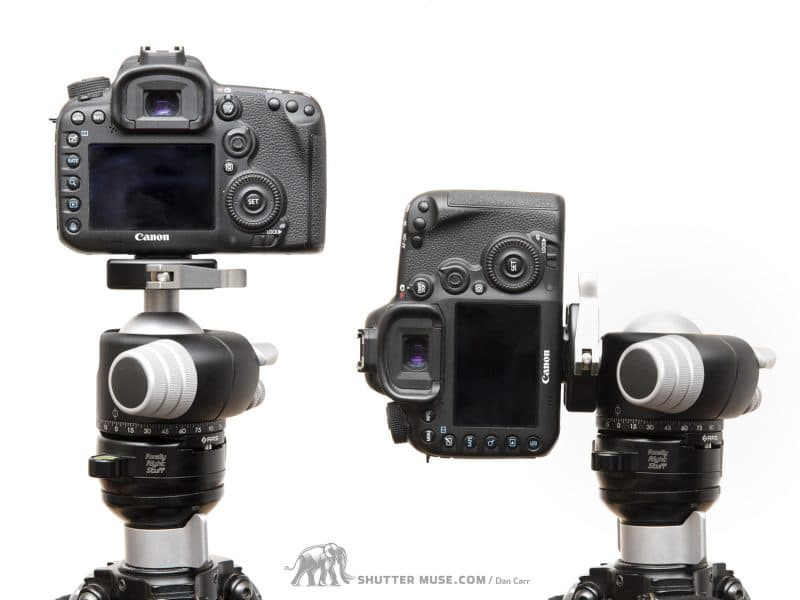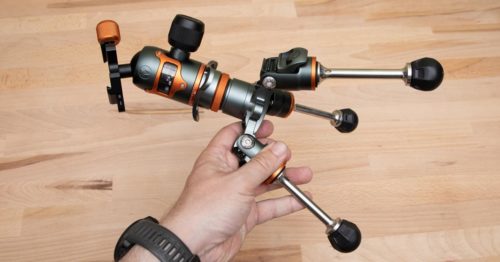An L-plate (sometimes called an L-bracket) is an accessory that stays permanently attached to your camera and allows you to clamp it to the ball head on your tripod. When I purchased my first L-plate about a decade ago, it was one of those “why the heck didn’t I do this before!!” moments, and since then I’ve had one on every camera I own. When people see me using it, or when I post photos of my camera setup on social media, I often get questions from people asking about “the funny bracket thing”. If you want to delve really deep into the topic of camera L-plates, I’ve previously written one of my long-form articles about them called: The Ultimate Guide to Camera L-plates.
If you want the distilled “Cliff Notes” version, that’s what I’m writing about today. Here’s my top 3 reasons that you should be using an L-plate on your camera.
1. They Speed Up The Shooting Process
L-plates use the Arca-Swiss standard quick-release system, which makes it incredibly fast to attach your camera to the ball head on your tripod. When the light is just right, it’s common to want to want to try getting some different compositions in both portrait and landscape orientation. With an L-plate on the camera you can swap orientations very quickly and only have to make minor adjustments to your ball head because you have effectively just rotated the camera close to the lens’ axis.
Without an L-plate you have to use the drop notch on the ball head to get into portrait orientation. You can see in the photo how the camera position is dramatically changed! Not only have you moved it to one side, but you’ve also lowered it, requiring much more fine tuning of your composition. Now your camera is also at a lower working height than it was before, so all that initial set up to get the camera at the perfect, comfortable working height has been wasted. Just thinking about it annoys me!
It’s common for landscape photographers to travel great distances and spend huge amounts of time waiting for the right light. When mother nature turns that light on, any speed advantage you can give yourself to get a variety of shots is worth it.
2. They Can Give You Sharper Images
If you’re not using an L-plate then it means you’re either using a smaller tripod plate, or you are simply spinning the camera onto a ball head using the 1/4 20″ thread on its base. Those other two options give you a much smaller contact point on the camera, and increase the risk of the camera rotating on the tripod plate. It’s annoying enough to have to constantly retighten things, but it can also lead to softer images as the camera moves a fractional amount during longer exposures. This is particularly a problem when you have flipped the camera into the ball head drop notch to take a photo in portrait orientation. When using the camera in that way, it’s common for the weight of the lens to cause the camera to sag slightly on a regular tripod plate leading to a soft image. A camera in the ball head drop notch is also much more susceptible to ball head sag, again lowering the sharpness of your images.

With an L-plate you have a much larger contact area on the base of the camera which keeps friction higher and prevents rotation on the base plate of the bracket. Camera-specific L-plates, such as those built by Really Right Stuff, actually “hug” the contours of the camera in multiple places, making any movement of the plate completely impossible. The plate almost becomes a part of the camera!
A L-plate also keeps the weight of the camera directly over the top of the tripod in portrait orientation, which greatly increases overall tripod stability on softer ground or in windier conditions which again leads to sharper images.
3. They Protect Your Camera
The L-plates wraps around the camera body and acts like a protective shell. It’s particularly useful for preventing dings and scratches on the base of the camera, allowing you to put the camera down on the ground without fear of damaging or devaluing it. if you ever decide to sell your camera, it’ll be in that much better condition that you’ll be able to ask a higher price for it and effectively get back the money you spend on the L-plate.
Which One Should You Buy?
Convinced yet? I hope so! The good news is that in the last few years there have been many more L-plate additions to the market, and now they can be had for a very reasonable price. There are a lot options, and these are explained in a bit more detail in that longer guide that I mentioned earlier, but the short version is that these are my recommendations in different price brackets:
- Budget Option – $39 – Sunway Photo Universal L-bracket
- Middle Option – $49 – 3-Legged Thing Universal L-plate. (Review here)
- High-End Option – $Varies – Really Right Stuff camera specific L-plates
- Wildcard Option for unique design – $89-130 – UniqBall iQuick Plates












What are the red hooks shown attached to the cameras in the images above? It looks like they do not interfere with the L-plate. What do you use them with?
Thanks.
Good question! They are the quick release Anchors from the Peak Design camera straps that I use. You can see a review of one of the straps here: http://shuttermuse.com/peak-design-slide-slide-lite-camera-strap-review/
Dan – bought myself a RRS L-plate ages ago, for my D810. Who the hell wants to pay all that money for a decent camera, and a heap more for a decent lens, and watch it all tip sideways because of the weight and lousy centre of gravity on a tripod head? Your second section really nailed it for me – and then I found to my great delight the benefits you outline in section 1. The other two benefits I get are ease of (and security of) attachment, and ease of release – and added protection for my camera body.
Thanks for joining the conversation Jean Pierre! I’m glad you’re already on board with this and found the article useful 🙂
Dan I use the “Camera Hand Clutch Strap, Black by Peak Design” to hold me camera. Can I still use it with the L-Plate? I have a 5DMIV how about access to the battery and cables compartments?
Thanks
Yes you can! I use the same hand strap too. The l-plates have a hole in them to attach the Pd anchor.
Dan, the only down side I see, is that you can’t use the peak design capture.
Well it seems that you have addressed this issue, in a different article, http://shuttermuse.com/ultimate-guide-to-camera-l-plates/
Thanks for the great content.
Yes indeed, that other post goes into more detail on this topic and does have a suggestion to solve that issue. Glad you found it useful!
Hello Dan, I actually have the same question on mind. Is the Peak Design Capture plate compatible with the 3LT QR11? I couldn’t find the solution in the article linked above. Thanks!
No, it’s not compatible. You need to find an L plate that has a 1/4 20 threaded hole on the bottom, which the 3LT one does not.
3 reasons not to:
1. They add weight
2. Pointless
3. Cost
You should have left it at two reasons. Two reasons not to would be cost and weight. But obviously they are not pointless. Time and time again they have proved their worth to me and many other people.
They are a solution without a problem. None of your three reasons above are valid reasons: They do not make anything faster. A decent tripod will not sag. And don’t drop your camera.
And yet I barely ever meet a fellow professional in the field that doesn’t have one on their camera. Go figure! We must all be wrong. Should we instead trust the opinion of someone that hides behind a fake name and a bogus email address? Doubtful.
Hello Dan, another great article, was fun to read.
I use mine only when i am traveling with my tripod. If my Tripod is at home, so is my L-plate.
As much as i appreciate the benefits of an L-plate, i don’t like the added weight and bulk. Especially the bulk is messing with my backpack and slingback.
The one i use is from SmallRig and also extends the grip, which I also don’t fancy, perhaps I’ll buy another on, which doesn’t extend the grip.
I am also not sure about the protection part other than keeping it from scratches. The material is not soft enough to absorb any shock from dropping it.
I didn’t mean to imply any drop protection from them, that’s certainly not the case. But it certainly does prevent scratches over the camera’s life, and that contributes to a higher resale value if you ever need to sell. That was the point I was making. Sorry if it wasn’t clear enough. I still consider protection from scratches to be protection. In the same was as a screen protector will not prevent impact damage to an LCD screen, but it is still protection from scratches.
Regarding bulk, yes, it can be an issue on tight fitting bags.
Thanks so much all those parties involved in assessing and asking such “questions to ask” I am appreciative for all your efforts and glad to have landed here. I am lovin it. Thanks for that initiative.
Hi Dan.
I can give you one really good reason not to use one, nobody does one for the 7DII with a battery grip installed, the best way to use a camera in portrait orientation! ☹️
Cheers, Graham.
I have a question. I don’t like ball heads for tripods, I find them cumbersome so I use a 3 axis head. This means I can’t use a L-plate effectively.Is there a way round this?
Why can’t you use an L-plate with a 3 axis head?
Yes you can :-). But you do need to have an Arca-Swiss type dovetail clamp on the head. If you have Bogen, you may be out of luck. If you have a screw on plate, you can find the clamps all over the internet, including Amazon for reasonable cost. I use a Benro geared 3-way head with my L-plate all the time.